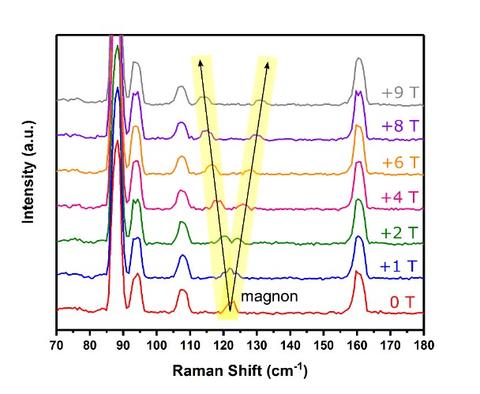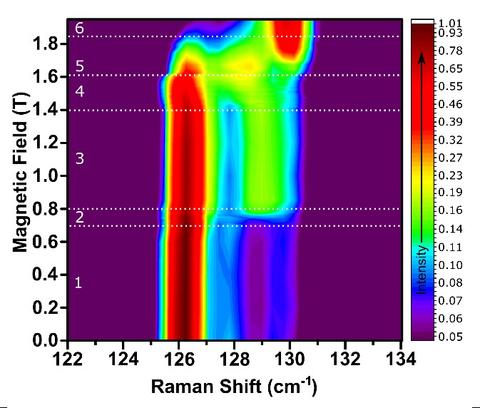Summary
We develop novel inelastic scattering methodologies to probe, quantify, and control key magnetic phenomena in 2D materials for applications in beyond CMOS, sensing and quantum information. 2D magnetism has significant potential for technological impact in areas such as spintronics and magnonics.
Description

A magnon, or spin wave, in a 1D chain.
The unique measurement capabilities developed in this Project enable diffraction-limited, optical spectra (both Raman and photoluminescence) to be collected and analyzed as a function of laser energy, polarization, temperature, magnetic field, and device parameters such as current load and back-gating. This resource is distinct within the US and critically valuable to characterize solid-state, magnetic materials and devices relevant to quantum information science. Sensitivity to the spin’s interactions with photons, electrons, phonons, and applied magnetic and electric fields, allow this measurement technique to realize the practical application of 2D magnetic quantum materials in new device architectures.
Common techniques used to measure magnon [spin wave] dispersions and other magnetic behavior such as inelastic neutron scattering and vibrating sample magnetometers are at a disadvantage due to their large sample size requirements. On the other hand, our unique Raman system, with diffraction-limited spatial resolution, is a powerful, non-destructive optical method to probe magnetism in 2D layered materials and device heterostructures. Of note, many of these material systems are air sensitive and need to be encapsulated in hBN, which is not a problem for our optical capabilities as the laser can probe right through non-absorbing capping layers.
The magnetic phase diagram of these materials is complex; a function of orientation, temperature, electric field, and strain. Spin structures can be mapped at 1 micron spatial resolution, allowing for studies of the following quantum phenomena: strong spin-orbit coupling, magnetic transitions, topological excitations, especially magnons, layer coupling through twisted graphene and/or TMD heterostructures, quantum spin liquids, especially ground state Kitaev physics, charge density waves, magnon-skyrmion transitions, Chern and Mott Insulators.
Distinguishing Magnons in 2D Magnets Through Their Symmetry

Transition metal phosphorus trihalides MPX3 (M = Fe, Mn, Ni, etc., X = S and Se) are a class of van der Waals antiferromagnets presently under study in the 2D limit. Even though this family of materials have the same crystal structure, the way in which the spins align below the magnetic ordering temperature is highly dependent on the choice of transition metal and halide, resulting in varied magnetic phenomena. Some of these materials support collective spin excitations called magnons, which are potential information carriers for next generation electronics called “magnonics.” These magnons can be excited and probed using laser light with Raman spectroscopy, even in atomically thin and micron-sized flakes. While it can be difficult to distinguish peaks associated to magnons from phonons using conventional Raman spectrometers, the unique capabilities developed in this project, specifically the abilities to control temperature, magnetic field, and polarization, allow us to identify both one-magnon and two-magnon excitations and study their symmetry properties that are dependent on magnetic ordering. For FePS3, Raman-active modes that appears in the magnetically ordered state, previously assigned as a phonon, was actually determined to be a magnon through careful magneto-Raman measurements. Detailed polarization characterization and analysis of the antiferromagnetic magnon challenged previously unquestioned “rules” in magnetic Raman scattering, including the interpretation that magnons are required to be antisymmetric. This work represented the first verification of a one-magnon excitation in a van der Waals magnet and will be instrumental in how we understand the selection rules of magnetic excitations in 2D quantum materials. As another example, we are currently investigating the hybridization of a phonon and two-magnon continuum and how the coupling depends on the laser excitation wavelength.
Probing Spin-Dependent Phonon Anomalies
When a material is cooled into its magnetically ordered state, there are many ways in which the resulting spin structure can affect the phonons we measure in Raman spectroscopy. Some examples include spin-phonon coupling that shifts the frequency of phonons, spin flips which change the symmetry properties of the phonons, magnetic field-induced changes in the band structure that can cause changes in the number and intensities of phonon, or coupling of the phonon to scattering continuums which result in the phonons having a Fano lineshape. Any of these changes in the spectra as a function of temperature, magnetic field, and electric field provide intricate details of the magnetic structure in the sample.

Among the 2D magnets studied include CrI3 and α-RuCl3. For the CrI3, which needs to be encapsulated in hBN due to air sensitivity, increasing the magnetic field at low temperatures (5 K) results in dramatic changes in the intensities and frequencies of certain phonons due to a magnetic field-induced phase transition. When the field is strong enough to change the interlayer spin alignment from antiferromagnetic to ferromagnetic, the symmetry of the phonons change, resulting in different polarization behavior. Studying this phase transition using Raman spectroscopy can be done without the need for contacts, probing the intrinsic properties of the material. In RuCl3, we observed a broad scattering continuum and two Fano line-shape resonances, where both the scattering continuum and the Fano asymmetry were found to vanish when the laser polarization was perpendicular to the honeycomb plan. This behavior strongly suggests that these effects are of 2D magnetic origin, even at room temperature, and is consistent with previous literature suggesting the continuum originate from the creation of Majorana fermion pairs.
New materials systems under study include chiral antiferromagnets and magnetic semiconductor.

